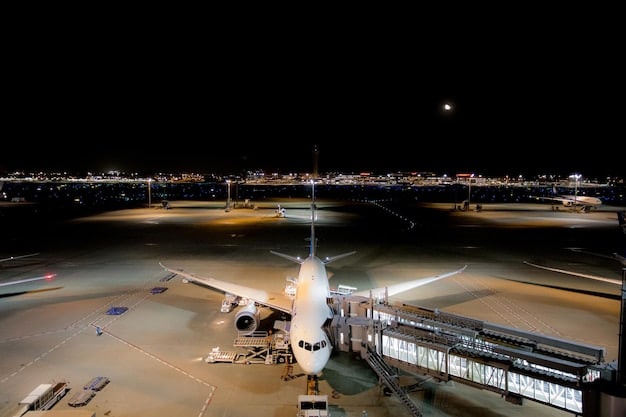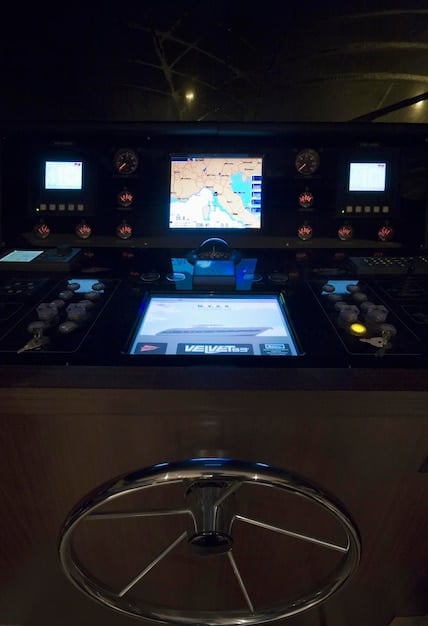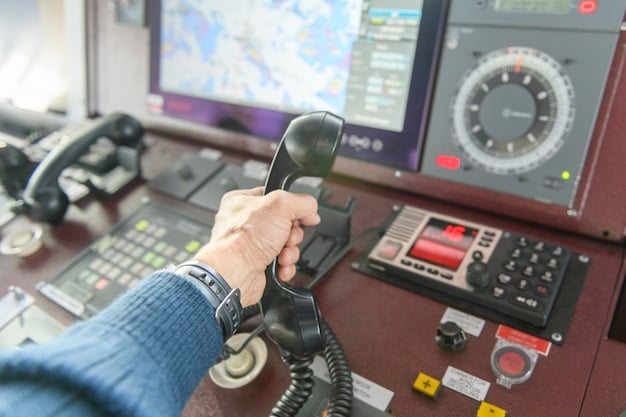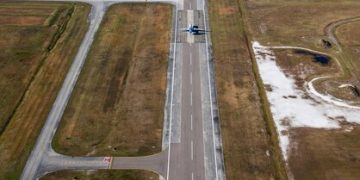FAA Investigates Near Misses: Planned Safety Improvements at Airports

The FAA is investigating a series of near miss incidents at major airports across the US, prompting a review of safety protocols and the implementation of improved technologies and procedures to prevent future occurrences.
The FAA Investigates Near Miss Incidents at Major Airports: What Safety Improvements Are Planned? Recent close calls at major airports have raised serious concerns about air travel safety, prompting immediate action from the Federal Aviation Administration (FAA).
FAA Launches Investigation into Near Miss Incidents
In response to a string of alarming near miss incidents at major airports throughout the United States, the FAA has initiated a comprehensive investigation. These incidents, where aircraft came dangerously close to colliding, have raised serious questions about the effectiveness of current safety measures and air traffic control procedures.
The investigation aims not only to determine the root causes of these near misses but also to identify systemic issues that might be contributing to an increased risk of such events. The FAA is working closely with airport authorities, airlines, and air traffic controllers to gather information and assess the circumstances surrounding each incident.

Scope of the FAA Investigation
The scope of the FAA’s investigation is broad, encompassing several key areas:
- Air Traffic Control Procedures: Examining whether current protocols are adequate to manage the increasing volume of air traffic.
- Communication Protocols: Assessing the clarity and effectiveness of communication between air traffic controllers and pilots.
- Technology and Infrastructure: Evaluating the performance and reliability of existing radar systems and other navigational aids.
The FAA’s commitment to thoroughly investigating these near miss incidents underscores its dedication to maintaining the highest standards of aviation safety. The findings from these investigations will be crucial in guiding future safety improvements and preventing similar occurrences.
The FAA’s rigorous approach to investigating near misses is essential for maintaining public trust in air travel and ensuring the safety of passengers and crew. The transparency and thoroughness of the investigation will be critical in identifying the necessary safety improvements and preventing future incidents.
Immediate Safety Measures Implemented
Following the near miss incidents, the FAA has swiftly implemented several immediate safety measures to address the most pressing concerns. These measures are designed to reduce the risk of similar incidents while the broader investigation is underway.
These immediate steps include enhanced training for air traffic controllers and pilots, stricter adherence to standard operating procedures, and increased monitoring of airport operations. The focus is on reinforcing existing safety protocols and improving communication to mitigate the risk of human error.
Specific Safety Enhancements
Some of the specific safety enhancements include:
- Increased Runway Monitoring: Enhanced surveillance of runways by air traffic controllers to detect and prevent unauthorized runway incursions.
- Enhanced Communication Procedures: Clearer and more concise communication protocols between air traffic controllers and pilots.
- Additional Training Exercises: More frequent and comprehensive training exercises for air traffic controllers to simulate various emergency scenarios.
The immediate safety measures reflect the FAA’s proactive approach to addressing safety concerns. These steps are intended to provide an added layer of protection while the long-term solutions are being developed and implemented. These measures are a testament to the FAA’s commitment to maintaining the highest safety standards in air travel.
By implementing these immediate safety measures, the FAA aims to reassure the public and the aviation industry that air travel remains safe. The effectiveness of these measures will be closely monitored as the investigation progresses.

Long-Term Safety Improvements Planned
Beyond the immediate measures, the FAA is planning a range of long-term safety improvements to address the systemic issues identified during the investigation. These improvements encompass technological upgrades, procedural changes, and enhanced training programs.
The long-term improvements are designed to create a more resilient and safer air transportation system. These plans reflect a commitment to continuous improvement and adaptation in response to evolving challenges in the aviation industry.
Technological Upgrades
Technological upgrades are a key component of the FAA’s long-term safety plan:
- NextGen Technology: Accelerating the deployment of NextGen technologies, which provide more precise and reliable air traffic management.
- Advanced Surveillance Systems: Implementing advanced surveillance systems to improve the detection and tracking of aircraft.
- Automated Warning Systems: Developing automated warning systems to alert air traffic controllers to potential conflicts.
These technological upgrades are expected to significantly enhance the safety and efficiency of air travel. The investment in advanced technologies underscores the FAA’s commitment to leveraging innovation to improve aviation safety. The implementation of these technologies will require careful planning and coordination to minimize disruptions to airport operations.
The integration of advanced technologies is crucial for addressing the increasing complexity of air traffic management. These upgrades will provide air traffic controllers with better tools and information to make informed decisions and prevent accidents.
Role of Technology in Preventing Near Misses
Technology plays a crucial role in preventing near miss incidents by providing air traffic controllers and pilots with real-time information, advanced warning systems, and enhanced situational awareness. Advanced technologies can help mitigate human error and improve the overall safety of air travel.
The FAA is committed to investing in and deploying cutting-edge technologies to enhance aviation safety. These investments are aimed at reducing the risk of near miss incidents and ensuring the continued safety of passengers and crew.
Specific Technological Solutions
Specific technological solutions include:
- Enhanced Ground Surveillance Systems: These systems use radar and other sensors to track aircraft and vehicles on the ground, providing air traffic controllers with a comprehensive view of airport operations.
- Runway Status Lights: These lights provide pilots with visual cues indicating whether it is safe to enter, cross, or take off from a runway.
- Data Communication Systems: These systems allow air traffic controllers and pilots to exchange information electronically, reducing the risk of miscommunication.
These technological solutions are essential for improving the safety and efficiency of air travel. They provide air traffic controllers and pilots with the tools they need to make informed decisions and prevent accidents. The FAA’s commitment to investing in and deploying these technologies demonstrates its dedication to maintaining the highest safety standards in the aviation industry.
By leveraging technology, the FAA aims to create a more resilient and safer air transportation system. The continuous advancement and integration of new technologies are critical for addressing the evolving challenges in the aviation industry.
Pilot and Air Traffic Controller Training Enhancements
In addition to technological upgrades, the FAA is also focusing on enhancing the training programs for pilots and air traffic controllers. These enhancements are designed to improve their skills, knowledge, and decision-making abilities, reducing the risk of human error.
Enhanced training programs are essential for maintaining a highly skilled and competent workforce. The FAA’s commitment to providing ongoing training and professional development opportunities is crucial for ensuring the safety and efficiency of air travel.
Key Training Initiatives
Some of the key training initiatives include:
- Advanced Simulation Training: Providing pilots and air traffic controllers with realistic simulation training to prepare them for various emergency scenarios.
- Crew Resource Management (CRM) Training: Enhancing CRM training to improve communication, coordination, and decision-making among flight crews and air traffic controllers.
- Continuous Professional Development: Offering continuous professional development opportunities to keep pilots and air traffic controllers up-to-date on the latest regulations, procedures, and technologies.
These training initiatives are designed to improve the skills and knowledge of pilots and air traffic controllers, reducing the risk of human error. The FAA’s commitment to investing in training and professional development is crucial for maintaining the highest safety standards in the aviation industry. The ongoing evaluation and improvement of training programs are essential for ensuring their effectiveness.
By investing in enhanced training programs, the FAA aims to create a more resilient and safer air transportation system. The continuous improvement of training programs is critical for addressing the evolving challenges in the aviation industry.
Collaboration with Stakeholders for Safer Skies
The FAA recognizes that collaboration with stakeholders, including airlines, airport authorities, and pilot unions, is essential for achieving safer skies. By working together, these stakeholders can share best practices, identify potential risks, and implement effective safety measures.
Collaboration is crucial for creating a culture of safety in the aviation industry. The FAA’s commitment to fostering open communication and collaboration among stakeholders is essential for ensuring the continued safety of air travel.
Stakeholder Engagement
The FAA engages with stakeholders through various means:
- Safety Meetings: Holding regular safety meetings with airlines, airport authorities, and pilot unions to discuss safety concerns and share best practices.
- Safety Audits: Conducting safety audits of airlines and airports to identify potential risks and ensure compliance with safety regulations.
- Joint Safety Initiatives: Collaborating with stakeholders on joint safety initiatives to address specific safety challenges.
These engagement efforts are designed to promote a collaborative approach to safety management. The FAA’s commitment to fostering open communication and collaboration among stakeholders is essential for ensuring the continued safety of air travel. The involvement of all stakeholders is crucial for identifying and addressing potential risks.
By working together, the FAA and its stakeholders can create a more resilient and safer air transportation system. The continuous engagement and collaboration among stakeholders are critical for addressing the evolving challenges in the aviation industry.
| Key Point | Brief Description |
|---|---|
| 🚨 FAA Investigation | Comprehensive probe into recent near miss incidents at major airports. |
| 🛠️ Safety Measures | Immediate actions taken to enhance runway monitoring and communication. |
| 🚀 Tech Upgrades | Planned implementation of NextGen technology and advanced surveillance. |
| 👨✈️ Training Enhancements | Improved programs for pilots and air traffic controllers. |
Frequently Asked Questions (FAQs)
▼
A series of near miss incidents at major airports across the US, where aircraft came dangerously close to colliding, prompted the FAA to launch a comprehensive investigation.
▼
The FAA implemented enhanced training for air traffic controllers and pilots, stricter adherence to standard operating procedures, and increased monitoring of airport operations.
▼
The FAA plans to accelerate the deployment of NextGen technologies, implement advanced surveillance systems, and develop automated warning systems to enhance aviation safety.
▼
Technology provides real-time information, advanced warning systems, and enhanced situational awareness to air traffic controllers and pilots, helping to mitigate human error and improve overall safety.
▼
The FAA engages with airlines, airport authorities, and pilot unions through safety meetings, safety audits, and joint safety initiatives to share best practices and address safety concerns collaboratively.
Conclusion
The FAA’s swift response to the near miss incidents, including immediate safety measures and planned long-term improvements, demonstrates a commitment to maintaining the highest standards of aviation safety. By leveraging technology, enhancing training, and collaborating with stakeholders, the FAA is working to create a more resilient and safer air transportation system for the traveling public.





